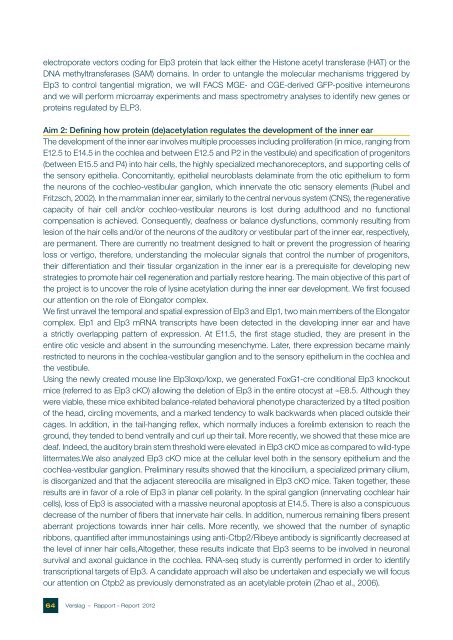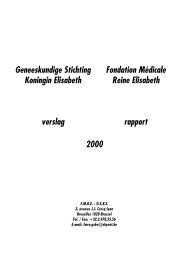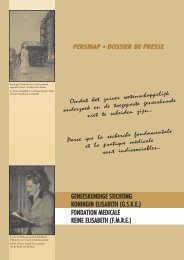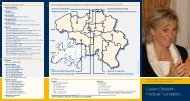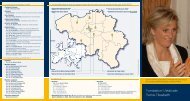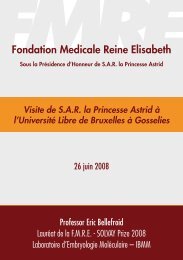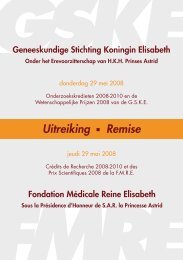electroporate vectors coding for Elp3 protein that lack either the Histone acetyl transferase (HAT) or the DNA methyltransferases (SAM) domains. In order to untangle the molecular mechanisms triggered by Elp3 to control tangential migration, we will FACS MGE- and CGE-derived GFP-positive interneurons and we will perform microarray experiments and mass spectrometry analyses to identify new genes or proteins regulated by ELP3. Aim 2: Defining how protein (de)acetylation regulates the development of the inner ear The development of the inner ear involves multiple processes including proliferation (in mice, ranging from E12.5 to E14.5 in the cochlea and between E12.5 and P2 in the vestibule) and specification of progenitors (between E15.5 and P4) into hair cells, the highly specialized mechanoreceptors, and supporting cells of the sensory epithelia. Concomitantly, epithelial neuroblasts delaminate from the otic epithelium to form the neurons of the cochleo-vestibular ganglion, which innervate the otic sensory elements (Rubel and Fritzsch, 2002). In the mammalian inner ear, similarly to the central nervous system (CNS), the regenerative capacity of hair cell and/or cochleo-vestibular neurons is lost during adulthood and no functional compensation is achieved. Consequently, deafness or balance dysfunctions, commonly resulting from lesion of the hair cells and/or of the neurons of the auditory or vestibular part of the inner ear, respectively, are permanent. There are currently no treatment designed to halt or prevent the progression of hearing loss or vertigo, therefore, understanding the molecular signals that control the number of progenitors, their differentiation and their tissular organization in the inner ear is a prerequisite for developing new strategies to promote hair cell regeneration and partially restore hearing. The main objective of this part of the project is to uncover the role of lysine acetylation during the inner ear development. We first focused our attention on the role of Elongator complex. We first unravel the temporal and spatial expression of Elp3 and Elp1, two main members of the Elongator complex. Elp1 and Elp3 mRNA transcripts have been detected in the developing inner ear and have a strictly overlapping pattern of expression. At E11.5, the first stage studied, they are present in the entire otic vesicle and absent in the surrounding mesenchyme. Later, there expression became mainly restricted to neurons in the cochlea-vestibular ganglion and to the sensory epithelium in the cochlea and the vestibule. Using the newly created mouse line Elp3loxp/loxp, we generated FoxG1-cre conditional Elp3 knockout mice (referred to as Elp3 cKO) allowing the deletion of Elp3 in the entire otocyst at ≈E8.5. Although they were viable, these mice exhibited balance-related behavioral phenotype characterized by a tilted position of the head, circling movements, and a marked tendency to walk backwards when placed outside their cages. In addition, in the tail-hanging reflex, which normally induces a forelimb extension to reach the ground, they tended to bend ventrally and curl up their tail. More recently, we showed that these mice are deaf. Indeed, the auditory brain stem threshold were elevated in Elp3 cKO mice as compared to wild-type littermates.We also analyzed Elp3 cKO mice at the cellular level both in the sensory epithelium and the cochlea-vestibular ganglion. Preliminary results showed that the kinocilium, a specialized primary cilium, is disorganized and that the adjacent stereocilia are misaligned in Elp3 cKO mice. Taken together, these results are in favor of a role of Elp3 in planar cell polarity. In the spiral ganglion (innervating cochlear hair cells), loss of Elp3 is associated with a massive neuronal apoptosis at E14.5. There is also a conspicuous decrease of the number of fibers that innervate hair cells. In addition, numerous remaining fibers present aberrant projections towards inner hair cells. More recently, we showed that the number of synaptic ribbons, quantified after immunostainings using anti-Ctbp2/Ribeye antibody is significantly decreased at the level of inner hair cells,Altogether, these results indicate that Elp3 seems to be involved in neuronal survival and axonal guidance in the cochlea. RNA-seq study is currently performed in order to identify transcriptional targets of Elp3. A candidate approach will also be undertaken and especially we will focus our attention on Ctpb2 as previously demonstrated as an acetylable protein (Zhao et al., 2006). 64 <strong>Verslag</strong> <strong>–</strong> <strong>Rapport</strong> <strong>–</strong> <strong>Report</strong> 2012
Bibliography <strong>–</strong> Akella, J.S., Wloga, D., Kim, J., Starostina, N.G., Lyons-Abbott, S., Morrissette, N.S., Dougan, S.T., Kipreos, E.T., and Gaertig, J. (2010). MEC-17 is an alpha-tubulin acetyltransferase. Nature 467, 218-222. <strong>–</strong> Anderson, S.A., Eisenstat, D.D., Shi, L., and Rubenstein, J.L. (1997). Interneuron migration from basal forebrain to neocortex: dependence on Dlx genes. Science 278, 474-476. <strong>–</strong> Bielas, S., Higginbotham, H., Koizumi, H., Tanaka, T., and Gleeson, J.G. (2004). Cortical neuronal migration mutants suggest separate but intersecting pathways. Annu Rev Cell Dev Biol 20, 593-618. <strong>–</strong> Choudhary, C., Kumar, C., Gnad, F., Nielsen, M.L., Rehman, M., Walther, T.C., Olsen, J.V., and Mann, M. (2009). Lysine acetylation targets protein complexes and co-regulates major cellular functions. Science 325, 834-840. <strong>–</strong> Choudhary, J., and Grant, S.G. (2004). Proteomics in postgenomic neuroscience: the end of the beginning. Nat Neurosci 7, 440-445. <strong>–</strong> Close, P., Creppe, C., Gillard, M., Ladang, A., Chapelle, J.P., Nguyen, L., and Chariot, A. (2010). The emerging role of lysine acetylation of non-nuclear proteins. Cell Mol Life Sci 67, 1255-1264. <strong>–</strong> Creppe, C., Malinouskaya, L., Volvert, M.L., Gillard, M., Close, P., Malaise, O., Laguesse, S., Cornez, I., Rahmouni, S., Ormenese, S., et al. (2009). Elongator controls the migration and differentiation of cortical neurons through acetylation of alpha-tubulin. Cell 136, 551-564. <strong>–</strong> Dompierre, J.P., Godin, J.D., Charrin, B.C., Cordelieres, F.P., King, S.J., Humbert, S., and Saudou, F. (2007). Histone deacetylase 6 inhibition compensates for the transport deficit in Huntington’s disease by increasing tubulin acetylation. J Neurosci 27, 3571-3583. <strong>–</strong> Gupta, A., Tsai, L.H., and Wynshaw-Boris, A. (2002). Life is a journey: a genetic look at neocortical development. Nat Rev Genet 3, 342-355. <strong>–</strong> Hempen, B., and Brion, J.P. (1996). Reduction of acetylated alpha-tubulin immunoreactivity in neurofibrillary tangle-bearing neurons in Alzheimer’s disease. J Neuropathol Exp Neurol 55, 964-972. <strong>–</strong> Kim, S.C., Sprung, R., Chen, Y., Xu, Y., Ball, H., Pei, J., Cheng, T., Kho, Y., Xiao, H., Xiao, L., et al. (2006). Substrate and functional diversity of lysine acetylation revealed by a proteomics survey. Mol Cell 23, 607-618. <strong>–</strong> Merrick, C.J., and Duraisingh, M.T. (2007). Plasmodium falciparum Sir2: an unusual sirtuin with dual histone deacetylase and ADP-ribosyltransferase activity. Eukaryot Cell 6, 2081-2091. <strong>–</strong> Rash, B.G., and Grove, E.A. (2006). Area and layer patterning in the developing cerebral cortex. Curr Opin Neurobiol 16, 25-34. <strong>–</strong> Reed, N.A., Cai, D., Blasius, T.L., Jih, G.T., Meyhofer, E., Gaertig, J., and Verhey, K.J. (2006). Microtubule acetylation promotes kinesin-1 binding and transport. Curr Biol 16, 2166-2172. <strong>–</strong> Ren, Q., and Gorovsky, M.A. (2001). Histone H2A.Z acetylation modulates an essential charge patch. Mol Cell 7, 1329- 1335. <strong>–</strong> Rubel, E.W., and Fritzsch, B. (2002). Auditory system development: primary auditory neurons and their targets. Annu Rev Neurosci 25, 51-101. <strong>–</strong> Spange, S., Wagner, T., Heinzel, T., and Kramer, O.H. (2009). Acetylation of non-histone proteins modulates cellular signalling at multiple levels. Int J Biochem Cell Biol 41, 185-198. <strong>–</strong> Zhao, L.J., Subramanian, T., Zhou, Y., and Chinnadurai, G. (2006). Acetylation by p300 regulates nuclear localization and function of the transcriptional corepressor CtBP2. J Biol Chem 281, 4183-4189. <strong>–</strong> Zhao, X., Heng, J.I., Guardavaccaro, D., Jiang, R., Pagano, M., Guillemot, F., Iavarone, A., and Lasorella, A. (2008). The HECT-domain ubiquitin ligase Huwe1 controls neural differentiation and proliferation by destabilizing the N-Myc oncoprotein. Nat Cell Biol 10, 643-653. Publications of the laboratory in 2012 supported by the F.M.R.E. <strong>–</strong> Godin, J., Thomas, N., Laguesse, S., Malinouskaya, L., Close, P., Malaise, P., Purnelle, A., Raineteau, O., Campbell, K., Fero, M., Moonen, G., Malgrange, B., Chariot, A., Metin, C, Besson, A., and Nguyen, L.: p27Kip1 is a microtubuleassociated protein that promotes microtubule polymerisation during neuron migration. Dev Cell (2012), 23 (4): 729-44 (I.F. 2011= 14.030) <strong>–</strong> Volvert, M.-L.., Rogister, F., Moonen, G., Malgrange, B., and Nguyen, L. : MicroRNAs tune cerebral cortical neurogenesis Cell Death Diff (2012), 19(10): 1573-81 (I.F. 2011= 8.849) <strong>–</strong> Beukelaers, P., Vandenbosch, R., Caron, N., Nguyen, L., Belachew, S., Moonen, G., and Malgrange, B CA . : Cycling or not cycling in the adult brain: Cell cycle regulatory molecules and adult neurogenesis Cell Mol Life Sci (2012), 69(9): 1493-503( (I.F. 2011= 6.570) <strong>Verslag</strong> <strong>–</strong> <strong>Rapport</strong> <strong>–</strong> <strong>Report</strong> 2012 65
- Page 1 and 2:
Verslag - Rapport - Bericht - Repor
- Page 3 and 4:
Fondation Médicale Reine Elisabeth
- Page 5 and 6:
Onderzoeksprogramma’s gefinancier
- Page 7 and 8:
Progress reports of the university
- Page 9 and 10:
Progress report of the research gro
- Page 11 and 12:
ß-actin in neural crest cell migra
- Page 13 and 14: In addition whole mount in situ hyb
- Page 15 and 16: In summary we show an essential rol
- Page 17 and 18: Progress report of the research gro
- Page 19 and 20: mRNA metabolism at synapses and spi
- Page 21 and 22: eIF4E upon DHPG stimulation, but Ra
- Page 23 and 24: REFERENCES - Bagni, C., Tassone, F.
- Page 25 and 26: Progress report of the research gro
- Page 27 and 28: Role of DMRT transcription factors
- Page 29 and 30: References - Borello U, Pierani A (
- Page 31 and 32: Progress report of the research gro
- Page 33 and 34: Molecular Genetics and Functional G
- Page 35 and 36: Granulin (GRN) Loss-of-function mut
- Page 37 and 38: Publications Acknowledging G.S.K.E.
- Page 39 and 40: - van der Zee J.: “A European con
- Page 41 and 42: Progress report of the research gro
- Page 43 and 44: Developmental origin of multiple de
- Page 45 and 46: additional experiments, which meanw
- Page 47 and 48: using Sip1-deficient, Cre-activated
- Page 49 and 50: Hirschsprung disease-mental retarda
- Page 51 and 52: Verslag - Rapport - Report 2012 51
- Page 53 and 54: Progress report of the research gro
- Page 55 and 56: Characterization of Human Sleep/Wak
- Page 57 and 58: delivery. These detected sounds wer
- Page 59 and 60: Progress report of the research gro
- Page 61 and 62: Unravelling the roles of lysine ace
- Page 63: candidate-based approach with a pro
- Page 67 and 68: Verslag - Rapport - Report 2012 67
- Page 69 and 70: Progress report of the research gro
- Page 71 and 72: Roles of Specific Neuronal Populati
- Page 73 and 74: clamp recording and optogenetics ha
- Page 75 and 76: 2 Regulation of striatal neurons ex
- Page 77 and 78: patch clamp recordings, presynaptic
- Page 79 and 80: - Schmidt H., Brachtendorf S., Aren
- Page 81 and 82: Progress report of the research gro
- Page 83 and 84: Unveiling the role of the cystine/g
- Page 85 and 86: We hypothesise that upregulation of
- Page 87 and 88: To support the view that the observ
- Page 89 and 90: - 5 Development of new x research t
- Page 91 and 92: Verslag - Rapport - Report 2012 91
- Page 93 and 94: Progress report of the research gro
- Page 95 and 96: Charcot-Marie-Tooth neuropathies; f
- Page 97 and 98: Reference List 1. Rotthier,A., Baet
- Page 99 and 100: Slide presentations selected at int
- Page 101 and 102: Progress report of the research gro
- Page 103 and 104: Celsr genes in brain development an
- Page 105 and 106: cells sometimes pointed to, or oppo
- Page 107 and 108: Verslag - Rapport - Report 2012 107
- Page 109 and 110: Progress report of the research gro
- Page 111 and 112: Study of the role of the NF-kB regu
- Page 113 and 114: Since A20 is a key negative regulat
- Page 115 and 116:
References - De Jager, P.L. et al.
- Page 117 and 118:
Verslag - Rapport - Report 2012 117
- Page 119 and 120:
Progress report of the research gro
- Page 121 and 122:
From stem cells to cortical network
- Page 123 and 124:
We have thus generated a unique exp
- Page 125 and 126:
Publications resulting from work pe


